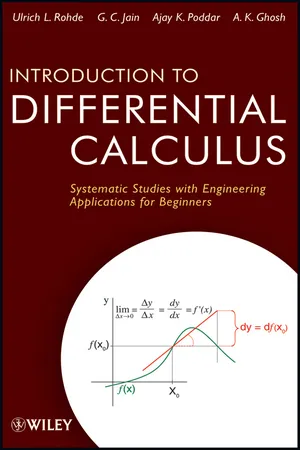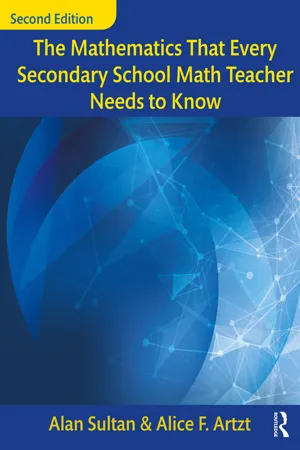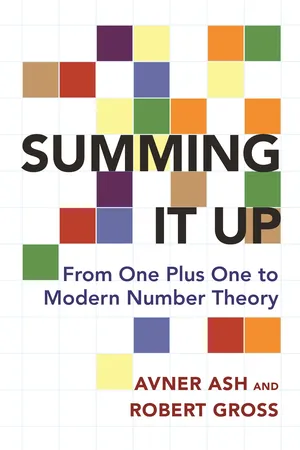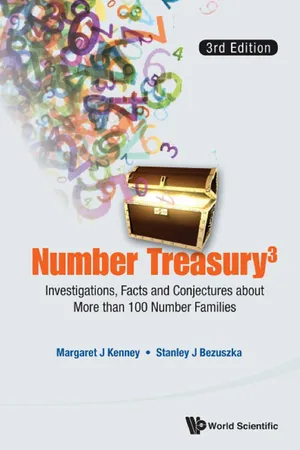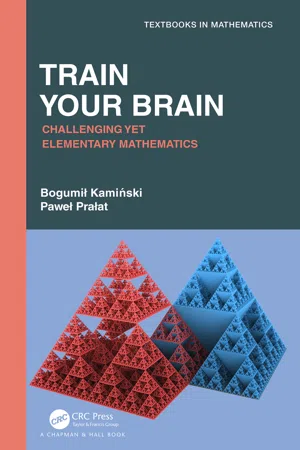Mathematics
Common Factors
Common factors in mathematics are numbers that can divide two or more other numbers without leaving a remainder. They are the numbers that are shared by multiple integers. Finding the common factors of two or more numbers is important in simplifying fractions, solving equations, and understanding the relationships between different numbers.
Written by Perlego with AI-assistance
Related key terms
Related key terms
1 of 4
Related key terms
1 of 3
7 Key excerpts on "Common Factors"
- eBook - ePub
- Mary Jane Sterling(Author)
- 2016(Publication Date)
- For Dummies(Publisher)
Pulling out factors and leaving the rest
Pulling out Common Factors from lists of terms or the sums or differences of a bunch of terms is done for a good reason. It’s a common task when you’re simplifying expressions and solving equations. The common factor that makes the biggest difference in these problems is the greatest common factor (GCF). When you recognize the GCF and factor it out, it does the most good.The greatest common factor is the largest-possible number that evenly divides each term of an expression containing two or more terms (or evenly divides the numerator and denominator of a fraction).In any factoring discussion, the GCF, the most common and easiest factoring method, always comes up first. And it’s helpful to know about the GCF when solving equations. In an expression with two or more terms, finding the greatest common factor can make the expression more understandable and manageable.When simplifying expressions, the best-case scenario is to recognize and pull out the GCF from a list of terms. Sometimes, though, the GCF may not be so recognizable. It may have some strange factors, such as 7, 13, or 23. It isn’t the end of the world if you don’t recognize one of these numbers as being a multiplier; it’s just nicer if you do.The three terms in the expression 12x 2 y 4 + 16xy 3 – 20x 3 y 2 - eBook - ePub
- Toby Wagner(Author)
- 2021(Publication Date)
- Chemeketa Press(Publisher)
B. Factoring Out the Greatest Common FactorIn the previous examples, we knew the product and one of the factors, so we simply used division to figure out the other factor. But suppose we’re given a polynomial product without any factors. We need to be able to determine a monomial that is a factor of each of the terms in the polynomial. If such a monomial exists, it’s called acommon factor. In the expression 8x + 12, for example, we know that 2 is a factor of 8x and of 12. We can thus use 2 as one factor and use division to find the other factor: = 4x + 6. We now rewrite 8x + 12 as 2(4x + 6). This is called factoring out a common factor.The Greatest Common Factor
Whenever we factor out a monomial from a polynomial, we try to find a monomial that is more than just a common factor of each term of the polynomial. We are looking for the greatest common factor of the terms in the polynomial.TheWhen dealing with a polynomial that has multiple terms, the GCF of theses terms has the following qualities: 1. The numerical coefficient is the GCF of the numerical coefficients of the terms of the polynomial.greatest common factor(GCF) of two numbers is the largest number that is a factor of each. For example, consider the numbers 8 and 12. The factors of 8 are 1, 2, 4, and 8. The factors of 12 are 1, 2, 3, 4, 6, and 12. The Common Factors are 1, 2, and 4. The greatest of these, 4, is the GCF of 8 and 12.2. The variables represent the lowest powers of the variables in the terms of the polynomial.The rule pertaining to variables might seem counterintuitive, so let’s consider x4 and x2 . The factors of x4 are 1, x, x2 , x3 , and x4 . The factors of x7 are 1, x, x2 , x3 , x4 , x5 , x6 , and x7 . When we compare these lists of factors, we see that x4 is the GCF of x4 and x7 .To factor out the GCF, we first must determine what the GCF is and write it. Then we divide each term of the original polynomial by the GCF and write the resulting polynomial in parentheses. - eBook - ePub
Introduction to Differential Calculus
Systematic Studies with Engineering Applications for Beginners
- Ulrich L. Rohde, G. C. Jain, Ajay K. Poddar, A. K. Ghosh(Authors)
- 2012(Publication Date)
- Wiley(Publisher)
composite number. Some examples of prime numbers are 2, 3, 5, 7, 11, 13, 17, 19, . . .. . ., and so on.- Each prime number, except 2, is odd .
- The number 1 is neither prime nor composite. Six is a composite number since it has four factors , namely 1, 2, 3, and 6.
A given natural number can be uniquely expressed as a product of primes.1.10 Coprime NumbersTwo natural numbers are said to be coprime (or relatively prime) to each other if they have no common factor except 1. For example, 8 and 25 are coprime to one another. Obviously, all prime numbers are coprime to each other.Remark: Coprime numbers need not be prime numbers.31.11 Highest Common Factor (H.C.F.)The highest common factor (H.C.F.) of two or more (natural) numbers is the greatest number which divides each of them exactly. It is also known as the greatest common divisor (G.C.D.). [The H.C.F. of any two prime numbers (or coprime numbers) is always 1.]1.12 Least Common Multiple (L.C.M.)The least common multiple (L.C.M.) of two or more (natural) numbers is the smallest number which is exactly divisible by each of them. To find the L.C.M. of two (or more) natural numbers, we find prime factors. If two (or more) numbers have a factor in common, we select it once. This is done for each such common factor and the remaining factors from each number are taken as they are. The product of all these factors taken together, gives the L.C.M. of the given numbers.1.12.1 Continuous Variables and Arbitrary ConstantsA changing quantity, usually denoted by a letter (i.e., x , y , z , etc.), which takes on any one of the possible values, in an interval, is called a variable . On the other hand, the set of letters a , b , c , d , and so on are used to denote arbitrary constants - Alan Sultan, Alice F. Artzt(Authors)
- 2017(Publication Date)
- Routledge(Publisher)
p is divided by 3 it leaves a remainder of 0, 1, or 2.- (c) Using the same method as in part (a), show that the only prime number p such that p and 8p 2 + 1 are prime is p = 3.
- 8 Show that for any integer k, k 3 + 2k is divisible by 3 by taking cases as we did in the previous problem.
2.6 The Greatest Common Divisor (GCD) and the Euclidean AlgorithmLaunchFind the greatest common divisor of 20 and 35. What method did you use to find the answer? Now find the greatest common divisor of 16,807 and 14,406. If you were able to find it, did you use the same method you used in the first problem? Why or why not?We imagine that you probably had a lot of difficulty finding the greatest common divisor (GCD) of the large numbers presented in the launch question. You might have used a “factoring tree” quite easily with the first pair of small numbers, but it is much more difficult to do with the pair of large numbers. The purpose of this section is to introduce you to an algorithm that will help you find the GCD rather easily and will give you other insights about numbers and their greatest common divisors.One of the fundamental topics stressed throughout the middle and secondary school curriculum is the greatest common divisor or greatest common factor of two numbers a and b . We denote this by gcd(a, b ). This is the largest number that divides both a and b . So for example, gcd(6, 8) is 2 and gcd(10, 15) = 5.The greatest common divisor is not only useful in mathematics. It has found uses in developing secure codes that even the National Security Agency can’t break, and hence is useful for our own national security. It has been used in developing certain musical rhythms and also in neutron accelerators as well as in computer design and so on. [An interesting article detailing some of this is “The Euclidean Algorithm Generates Traditional Musical Rhythms,” by Godfried Toussaint (2005)] On page 5 of the book Number Theory in Science and Communication- eBook - ePub
Summing It Up
From One Plus One to Modern Number Theory
- Avner Ash, Robert Gross(Authors)
- 2016(Publication Date)
- Princeton University Press(Publisher)
PART ONEFinite SumsPassage contains an image
Chapter 1PROEMIn the interest of allowing the reader to enjoy our book without constantly referring to many other references, we collect in this chapter many standard facts that we will often use in the remainder of the book. A reader familiar with elementary number theory can skip this chapter and refer back to it when necessary. We covered most of these topics in Ash and Gross (2006).1. Greatest Common DivisorsIf a is a positive integer and b is any integer, then long division tells us that we can always divide a into b and get an integer quotient q and integer remainder r. This means that b = qa + r, and the remainder r always satisfies the inequality 0 ≤ r < a. For example, if we take a = 3 and b = 14, then 14 = 4 · 3 + 2; the quotient q = 4 and the remainder r = 2. You may not be used to thinking about it, but you can do this with b < 0 also. Take b = –14 and a = 3, and –14 = (–5) · 3 + 1; the quotient is q = – 5, and the remainder is r = 1. Notice that if we divide by 2, the remainder will always be 0 or 1; if we divide by 3, the remainder will always be 0, 1, or 2; and so on.If the result of the long division has r = 0, then we say that “a divides b.” We write this sentence symbolically as a | b. Of course, one requirement for long division is that a cannot be 0, so whenever we write a | b, we implicitly assert that a ≠ 0. If the remainder r is not zero, we say that “a does not divide b.” We write that assertion symbolically as a∤ b. For example, 3 | 6, 3∤ 14, and 3∤ (–14). Notice that if n is any integer (even 0), then 1 | n. Also, if a is any positive integer, then a | 0. At the risk of giving too many examples, we also point out that 2 | n means that n is even, and 2∤ n means that n is odd.Suppose now that m and n are integers that are not both 0. We can then define the greatest common divisor:DEFINITION: The greatest common divisor of m and n, symbolically written (m, n), is the largest integer d such that d | m and d | n. If the greatest common divisor of m and n is 1, we say that m and n are relatively prime - eBook - ePub
Number Treasury3
Investigations, Facts and Conjectures about More than 100 Number Families
- Margaret J Kenney, Stanley J Bezuszka(Authors)
- 2015(Publication Date)
- WSPC(Publisher)
Chapter 2
Numbers Based on Divisors and Proper Divisors
Mathematics is the queen of the sciences and number theory is the queen of mathematics.Carl Friedrich Gauss (1777–1855)Do you know that the divisors of a number and its primality are related to cryptography? Several secure cipher systems are based on the fact that large numbers are extremely difficult to factor even when using the most powerful computers and efficient algorithms.Some details about the divisors of a number and their historical connections are provided below to serve as a catalyst for investigation and further exploration.Positive Integers
The numbers in the set {1, 2, 3, 4, 5, . . .} are the positive integers.Nearly all the integers used in this book are positive integers; so to simplify discussions the word integers, unless otherwise indicated, will be used to mean positive integers.Divisors, Multiples, and Proper Divisors
The divisors of an integer are those integers that divide the given integer evenly, that is, with zero remainder. The divisors of an integer are also called integral divisors, exact divisors or factors. The set of divisors of the integer n is denoted Dn .In the expression,a = b × cwhere a, b, and c are integers,b and c are divisors of aand a is a multiple of b (or c).EXAMPLEFind the divisors of 6.The divisors of 6 are the integers 1, 2, 3, 6.6 ÷ 1 = 6, remainder 0 6 ÷ 2 = 3, remainder 0 6 ÷ 3 = 2, remainder 0 6 ÷ 4 = 1, remainder 2 6 ÷ 5 = 1, remainder 1 6 ÷ 6 = 1, remainder 0 Write D6 = {1, 2, 3, 6}.If the integer itself is excluded from the set of its divisors, the new set is called the set of proper divisors of the integer, or the set of aliquot parts. The set of proper divisors of the integer n is denoted PDn .EXAMPLEThe proper divisors of 6 are 1, 2, and 3. Write PD6 - eBook - ePub
Train Your Brain
Challenging Yet Elementary Mathematics
- Bogumil Kaminski, Pawel Pralat(Authors)
- 2020(Publication Date)
- Chapman and Hall/CRC(Publisher)
Chapter 5 Number Theory DOI: 10.1201/9781003097983-6 5.1 Greatest Common Divisors 5.2 Modular Arithmetic 5.3 Factorization 5.4 Fermat's Little Theorem and Euler's Theorem 5.5 Rules of Divisibility 5.6 Remainders 5.7 Aggregation 5.8 Equations As usual, we start the chapter with some basic definitions. THEORY Divisibility For any two integers a and b, we say that a divides b (or a is a divisor of b) if and only if b / a ∈ Z ; that is, b = a k for some k ∈ Z. If a divides b, then we write a | b. For example, 5 | 15 since 15 / 5 = 3 ∈ Z. On the other hand, 5 | 7. Indeed, for a contradiction suppose that 5 | 7 ; that is, 7 = 5 k for some k ∈ Z. But this implies that k = 7 / 5 ∉ Z which gives the desired contradiction. For any b ∈ Z, we have 1 | b and b | b (since b / 1 = b ∈ Z and b / b = 1 ∈ Z). On the other hand, for any integer a > 1, a | 1 (since 1 / a ∉ Z). In fact, the following more general property holds: for all a, b ∈ N, if a > b, then a | b (5.1) (again, since 0 < b / a < 0 and so b / a ∉ Z). Let us note that divisibility is transitive; that is, if a | b and b | c, then a | c. Indeed, suppose a | b and b | c. It means that there exist k, ℓ ∈ Z such that b = a k and c = b ℓ. Thus, c = b ℓ = (a k) ℓ = a (k ℓ) and, since k ℓ ∈ Z, we get that a | c. Prime Numbers A positive integer p is said to be prime if and only if it has exactly two distinct positive divisors, namely, 1 and p. A positive integer p is said to be composite if it has more than two distinct positive divisors. The first few primes are 2, 3, 5, 7, 11, 13, 17, 19, 23, 29, …. Note that 1 has exactly one positive divisor so it is nether prime nor composite. On the other hand, it is easy to see that every integer greater than 1 is either prime or composite. Finally, let us mention that the set of prime numbers is infinite
Index pages curate the most relevant extracts from our library of academic textbooks. They’ve been created using an in-house natural language model (NLM), each adding context and meaning to key research topics.
Explore more topic indexes
Explore more topic indexes
1 of 6
Explore more topic indexes
1 of 4


